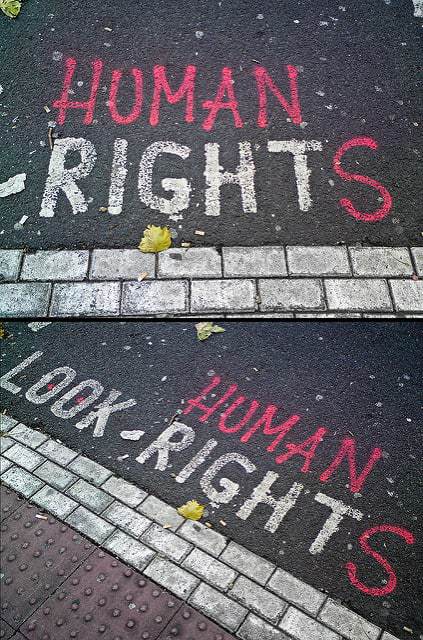The task of reviewing Mark Goodale’s Anthropology and Law: A Critical Introduction was weird, in a fractal way. The book itself, the object of my review, is, in fact, a review itself of recent work in legal anthropology. Moreover, the book begins with a foreword by Sally Engle Merry who already offers a review of the book with presenting what is to come and vouching for its merit. This means that my task was to write a review of a review that already has a review bound into its foreword. Once you get past all of that, there is the question of the book’s contents, which are concise, exemplary, often fun to read, yet hard to evaluate.
Formally, the book examines new work in legal anthropology since the end of the cold war.
It is broken up into areas of inquiry that Goodale identifies as encompassing most of legal anthropological practice. Goodale starts with an introduction that glosses over the history of legal anthropology, which mirrors the larger discipline up until the mid-1980s. This section starts in the 19th century with law that develops with “civilization” in some evolutionary sense. Then the author turns to Malinowski’s development of participant observation in social anthropology and the fascination with a “relationship between rules, or norms, and the complexities of social practice” (14). Moving into the work of Gluckman and P. Bohannan with a debate of emic or etic categories in relation to a method for studying legal systems, this section is followed by Nader and co.’s suggestion that legal anthropology really should be concerned with studying the dispute resolution processes. Finally, we arrive at an intellectual divide in the 1980s that concludes, “the problem of cross-cultural definitions of law and its institutions, was an intellectual and disciplinary dead end” (18). The discipline does not end there, but what comes next defies easy categorization to any particular theoretical paradigm according to Goodale.

Photo by Steve Parkinson (flickr, CC BY-NC-ND 2.0)
After clearing the above, Goodale suggests his own schema for understanding contemporary legal anthropology, and breaks it up into three distinct book sections categorized as: I. Law and the Production of Meaning, II. Law and Agency/Law as Regulation, and III. Law and Identity. The categories are further broken up into 8 chapters, and the 8 chapters are, in turn, broken up into 25 subsections (excluding all introductory and concluding sections). While there is a larger theoretical structure to Goodale’s book, ultimately the sections have a catch-all quality to them. Goodale acknowledges this suggesting that, “what follows is an admittedly idiosyncratic examination of the many ways in which anthropologists have transformed—sometimes against their better judgment the study of law…” (2).
This review is set against a historical schema in which the fall of the Soviet Union led to an interregnum of legal utopianism in which multilateral and NGO organizations flourished, all under the banner of legal universalism, human rights laws, contracts, and courts, to push a utopian ideology of universal human rights and various forms of global governance.
Social analysts are now at the far side of this interregnum. They can see the ways in which this utopian legal architecture has been repurposed and coopted for narrower chauvinistic and capitalist ends. This repurposing often reinforces the inequality that civil rights rhetoric and the utopianism of a few decades ago sought to mitigate and ultimately destroy (c.f. 188), i.e. ascendant ethnic nationalism and, somehow, also transnational neoliberal capitalism. But rather than a systematic or empirical argument the content reviewed in the book’s sections and its chapters are idiosyncratic.
To give one example of what this looks like, here follows a schematic outline of Chapter 4 “Human Rights and the Politics of Aspiration” from Part II, “Law and Agency, Law as Regulation:
- Part II: Law and Agency, Law as Regulation, which contains the chapter:
- Chapter 4, “Human Rights and the Politics of Aspiration,” which has sections on:
– “From Cultural Difference to a Right to Culture”
– “Human Rights and its Networks”
– “Moral Creativity and the Practice of Human Rights”
– “The Politics of Aspiration and the Limits of Human Rights” and
– “The Ethnographic Political Economy of International Law.”
- Chapter 4, “Human Rights and the Politics of Aspiration,” which has sections on:
All this is to show the various ways in which, “the anthropology of human rights has become the critical ethnography of one of the key ideas of contemporary world-making, with lessons that go well beyond anthropology itself” (97). Each of the sub-sections contains a brief summary of related ethnographic work, any of which would be an excellent starting point for other scholars. From a descriptive point of view, this is often interesting, but as to the logic of such categorization, we’re more or less left relying on Goodale’s expertise.

Photo by Woody Hibbard (flickr, CC BY 2.0)
In a way, this difficulty also tells us a bit about how academia works. Goodale’s author’s blurb notifies us that he is Professor of Cultural and Social Anthropology at the University of Lausanne, and that he was previously Professor of Conflict Studies and Anthropology at George Mason University, as well as the First Marjorie Shostak Distinguished Lecturer in Anthropology at Emory University. Moreover, he is the author of 12 books, numerous articles, received numerous grants and so on. In his own preface, he tells us that the work in this volume has been presented in various forms at 19 different Universities and Centers, and that 8 senior scholars have specifically revised portions of this book. All this is to show that the book has been vetted and is as much a product of Goodale’s as it is one of the discipline.
One of these senior scholars is the already mentioned Sally Engle Merry, the Silver Professor of Anthropology at NYU, an extensively published author in human rights law and gender scholarship. The cumulative effect is, insofar as theirs is an admittedly idiosyncratic presentation of the current state of legal anthropology (though persuasively presented and set against a compelling theory of the current historical moment), and insofar as this author and his work has been as vetted and vouched for as much as anthropologists can be, I’m not sure what grounds I have to critique. Basically, the book has already been reviewed and approved by The Discipline.
Perhaps, then, what might be of some consequence, is a suggestion for how to use this book.

There is no way around the fact that a book like this fluidly discusses a wide range of ethnographic primary studies, and a long thoughtful engagement with legal anthropology. It might help books like this to clearly it’s sampling strategy of literature and references as well as an explanation of what and why conceptual areas are neglected (e.g. economics and religion which are briefly noted on p. xiii) and how the author sees them fitting into the anthropology of law. In the absence of a clear answer to these questions or a more schematic presentation, we are left with an appeal to authority. The framing of the book’s material precludes systematic critique, but I am happy to give it the benefit of the doubt, and will certainly make good use of this book as a reference.
Goodale, Mark. 2017. Anthropology and Law: A Critical Introduction. New York: New York University Press. 320 pp. Pb $35.00. ISBN: 9781479895519.
**********
Featured image (cropped) by Ghazaleh Ghazanfari (flickr, CC BY-ND 2.0)







